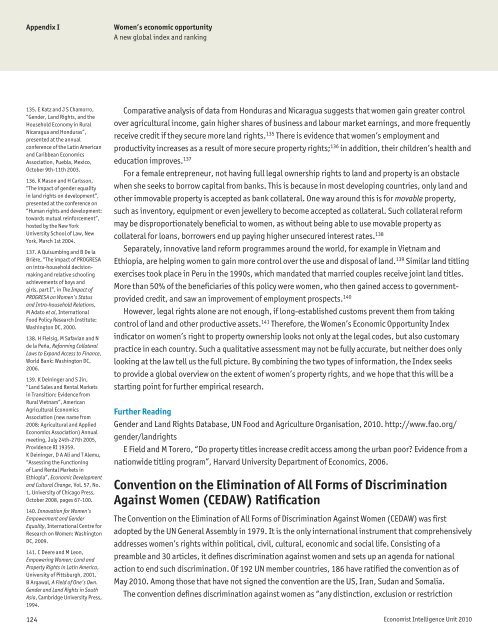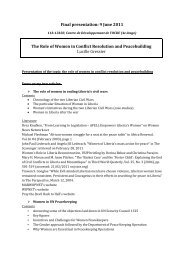Women's Economic Opportunity Index - Economist Intelligence Unit
Women's Economic Opportunity Index - Economist Intelligence Unit
Women's Economic Opportunity Index - Economist Intelligence Unit
- No tags were found...
Create successful ePaper yourself
Turn your PDF publications into a flip-book with our unique Google optimized e-Paper software.
Appendix IWomen’s economic opportunityA new global index and ranking135. E Katz and J S Chamorro,“Gender, Land Rights, and theHousehold Economy in RuralNicaragua and Honduras”,presented at the annualconference of the Latin Americanand Caribbean <strong>Economic</strong>sAssociation, Puebla, Mexico,October 9th-11th 2003.136. K Mason and H Carlsson,“The impact of gender equalityin land rights on development”,presented at the conference on“Human rights and development:towards mutual reinforcement”,hosted by the New YorkUniversity School of Law, NewYork, March 1st 2004.137. A Quisumbing and B De laBrière, “The impact of PROGRESAon intra-household decisionmakingand relative schoolingachievements of boys andgirls, part I”, in The Impact ofPROGRESA on Women’s Statusand Intra-household Relations,M Adato et al, InternationalFood Policy Research Institute:Washington DC, 2000.138. H Fleisig, M Safavian and Nde la Peña, Reforming CollateralLaws to Expand Access to Finance,World Bank: Washington DC,2006.139. K Deininger and S Jin,“Land Sales and Rental Marketsin Transition: Evidence fromRural Vietnam”, AmericanAgricultural <strong>Economic</strong>sAssociation (new name from2008: Agricultural and Applied<strong>Economic</strong>s Association) Annualmeeting, July 24th-27th 2005,Providence RI 19359.K Deininger, D A Ali and T Alemu,“Assessing the Functioningof Land Rental Markets inEthiopia”, <strong>Economic</strong> Developmentand Cultural Change, Vol. 57, No.1, University of Chicago Press,October 2008, pages 67-100.140. Innovation for Women’sEmpowerment and GenderEquality, International Centre forResearch on Women: WashingtonDC, 2009.141. C Deere and M Leon,Empowering Women: Land andProperty Rights in Latin America,University of Pittsburgh, 2001.B Argawal, A Field of One’s Own.Gender and Land Rights in SouthAsia, Cambridge University Press,1994.Comparative analysis of data from Honduras and Nicaragua suggests that women gain greater controlover agricultural income, gain higher shares of business and labour market earnings, and more frequentlyreceive credit if they secure more land rights. 135 There is evidence that women’s employment andproductivity increases as a result of more secure property rights; 136 in addition, their children’s health andeducation improves. 137For a female entrepreneur, not having full legal ownership rights to land and property is an obstaclewhen she seeks to borrow capital from banks. This is because in most developing countries, only land andother immovable property is accepted as bank collateral. One way around this is for movable property,such as inventory, equipment or even jewellery to become accepted as collateral. Such collateral reformmay be disproportionately beneficial to women, as without being able to use movable property ascollateral for loans, borrowers end up paying higher unsecured interest rates. 138Separately, innovative land reform programmes around the world, for example in Vietnam andEthiopia, are helping women to gain more control over the use and disposal of land. 139 Similar land titlingexercises took place in Peru in the 1990s, which mandated that married couples receive joint land titles.More than 50% of the beneficiaries of this policy were women, who then gained access to governmentprovidedcredit, and saw an improvement of employment prospects. 140However, legal rights alone are not enough, if long-established customs prevent them from takingcontrol of land and other productive assets. 141 Therefore, the Women’s <strong>Economic</strong> <strong>Opportunity</strong> <strong>Index</strong>indicator on women’s right to property ownership looks not only at the legal codes, but also customarypractice in each country. Such a qualitative assessment may not be fully accurate, but neither does onlylooking at the law tell us the full picture. By combining the two types of information, the <strong>Index</strong> seeksto provide a global overview on the extent of women’s property rights, and we hope that this will be astarting point for further empirical research.Further ReadingGender and Land Rights Database, UN Food and Agriculture Organisation, 2010. http://www.fao.org/gender/landrightsE Field and M Torero, “Do property titles increase credit access among the urban poor? Evidence from anationwide titling program”, Harvard University Department of <strong>Economic</strong>s, 2006.Convention on the Elimination of All Forms of DiscriminationAgainst Women (CEDAW) RatificationThe Convention on the Elimination of All Forms of Discrimination Against Women (CEDAW) was firstadopted by the UN General Assembly in 1979. It is the only international instrument that comprehensivelyaddresses women’s rights within political, civil, cultural, economic and social life. Consisting of apreamble and 30 articles, it defines discrimination against women and sets up an agenda for nationalaction to end such discrimination. Of 192 UN member countries, 186 have ratified the convention as ofMay 2010. Among those that have not signed the convention are the US, Iran, Sudan and Somalia.The convention defines discrimination against women as “any distinction, exclusion or restriction124 <strong>Economist</strong> <strong>Intelligence</strong> <strong>Unit</strong> 2010




